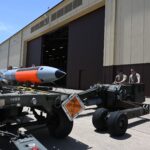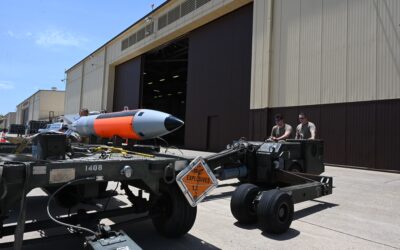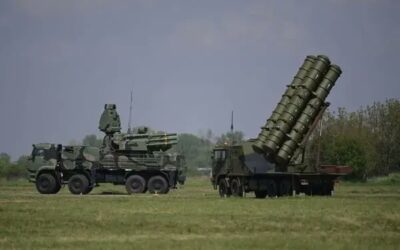The National Nuclear Security Administration (NNSA) of the US Department of Energy announced a few days ago that the life extension…

The Israel Defence Forces (IDF) announced that they used, for the first time, the “C-Dome” air defence system, the naval version of the Iron Dome, to counter an unidentified aerial object.
On Monday night, the Israeli military declared an alert in the city of Eilat, which is located at the southern tip of Israeli territory and was targeted in February.

Tonight a Sa'ar 6-Class Corvette of the Israeli Navy believed to possibly be the INS Magen, conducted the First Successful Combat Interceptions of its “C-Dome” Surface-to-Air Missile System over the Northern Red Sea near the City of Eilat; the C-Dome, which is a Ship mounted… pic.twitter.com/7ToqWGClbU
— OSINTdefender (@sentdefender) April 8, 2024
Naval forces in the wider area detected a suspicious aerial target flying over Israeli territory. The target was successfully intercepted by the C-Dome naval defence system, the IDF said in a laconic statement, assuring that they received no reports of any injuries or damage.
Asked about this by AFP, the Israeli military did not specify whether the suspected aerial system was a drone or a missile; however, it confirmed that it was the first operational use of the C-Dome, which is installed on the Sa’ar 6-type corvettes.

Combat proven!
Overnight, the Israeli Navy successfully deployed RAFAEL's C-DOME to intercept a suspicious hostile target in the Red Sea. C-DOME is the naval version of the Iron Dome and is integrated on the Israeli Navy's Sa'ar 6 corvette. This achievement serves as a major… pic.twitter.com/D91fKN3eqC
— Rafael Advanced Defense Systems (@RAFAELdefense) April 9, 2024
The system is the naval version of the Iron Dome system, which has been used for more than a decade to intercept threats such as rockets fired by Hamas and the Palestinian Islamic Jihad from the Gaza Strip.
Also read: Israel | New upgraded version of Iron Dome unveiled – To be installed on warships – VIDEO
The C-Dome does not need to be fully integrated into the vessel, as it can be moved to a firing position only when the threat is visible and returned to its position when it is not needed. Therefore, it does not require any deck penetration, vessel hull retrofitting, cable routing or complex integration with the ship’s systems.
In addition, thanks to its reduced footprint, it can be installed on vessels that previously could not be equipped with air defence systems and, owing to its own independent sensors, it can conduct the full engagement cycle from search to target acquisition in support of Tamir interceptor missiles. The system may still be networked with other air defence systems in case of network-centric operations.

#BREAKING: This is the so-called response of the #Iran's regime to the killing of the #IRGC Quds Force Generals by #Israel. The #Iraqi proxies of IRGC launched Shahed-101 suicide drones at #Eilat & an #IsraeliNavy Sa'ar 6 corvette shot them down via its C-DOME air defence system. pic.twitter.com/kYTbQNwEjj
— Babak Taghvaee – The Crisis Watch (@BabakTaghvaee1) April 8, 2024
The system consists of two main elements: a Command, Control, Detection station and a launcher. The first is equipped with three workstations and can be connected to the ship’s existing surveillance and tracking radar. Otherwise, it comes with its own EO/IR and a suite of multi-function radars added to the top of the station.
Also read: Iron Dome (?) for Cyprus
Rafael has so far integrated the Toplite EO/IR turret and a Rada radar with a 360° coverage range thanks to four fixed panels, but the system can be directed by other radars and EO/IR turrets, provided that their specifications and capabilities can be combined with the Tamir missiles.
The launch module, in which up to four launchers can be integrated, is 6.1 meters long, 2.4 meters wide, and 4.4 meters high and can accommodate two vertical launchers with 10 interceptors each in a standard loading surface of 20 feet, for a total of 20 interceptors per launch unit and a total weight of 12 tons, providing protection against most modern threats.
The Tamir interceptor missile requires no maintenance and has a maximum speed of Mach 2.2, it incorporates a proximity fuze and has an operational range of over 10 km.
The Israeli military has invested in this technology in recent years to specifically protect large gas fields in the Mediterranean. Recently, Israel began exploiting the Tamar and Leviathan offshore fields in the hope of gaining energy independence and starting gas exports to the Middle East and Europe, according to APE.
Also read: I-Dome | The innovative, mobile version of Iron Dome
READ MORE
Serbia | The FK-3 Air Defence System for the First Time in Operational Service
Serbia has become the first European country to operationalise Chinese-made FK-3 air defence missile systems.
HOUTRIS | Specialised Vehicles and Specialised Solutions for Defence and Security at BATTLEFIELD REDEFiNED 2024
HOUTRIS, a Cypriot company with over four decades of experience, has established itself as a pioneer in the design and manufacturing of…
USA | Upgrade of B61-12 Gravity Nuclear Bombs with a Program Worth 9 Billion Dollars
The National Nuclear Security Administration (NNSA) of the US Department of Energy announced a few days ago that the life extension…
Turkaegean | Cancellation of the European Trademark
The European trademark “Turkaegean” is cancelled by decision of the European Union Intellectual Property Office (EUIPO) (C58927, 10/01/25)…
USA | Bipartisan Resolution Calls on Trump to Take Political Action on the Cyprus Issue
A cross-party resolution condemning Turkey’s illegal occupation of Cyprus was tabled in the House of Representatives by…
Serbia | The FK-3 Air Defence System for the First Time in Operational Service
Serbia has become the first European country to operationalise Chinese-made FK-3 air defence missile systems.
Lebanon | General Joseph Aoun is the New President
After 12 failed attempts, Lebanon’s parliament elected the chief of the armed forces, General Joseph Aoun, as the…
HOUTRIS | Specialised Vehicles and Specialised Solutions for Defence and Security at BATTLEFIELD REDEFiNED 2024
HOUTRIS, a Cypriot company with over four decades of experience, has established itself as a pioneer in the design and manufacturing of…



















